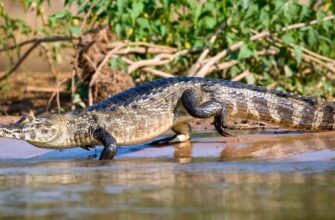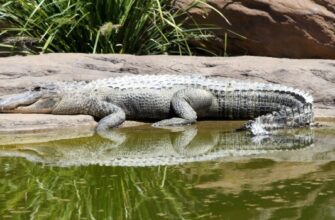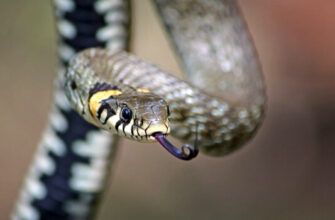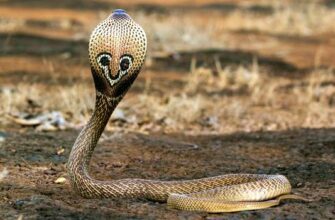According to legends and foreign cinema, the anaconda — incredibly huge and dangerous snake. Surprisingly, it is not uncommon to hear from people about the size of the anaconda, exceeding their true size by two — three times. This, of course, is all fairy tales and fictions, once transferred as official data. Everything is much more modest, the anaconda is indeed the largest snake, but only statistically. She is also quite calm and is not interested in such large prey as humans.
View origin and description
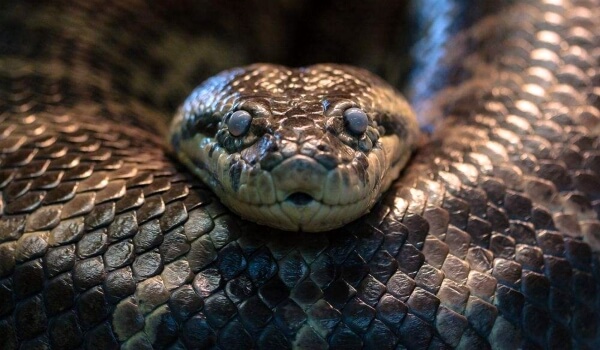
Photo: Anaconda
Anacondas belong to the subfamily of boas of the false-legged family, scaly order, reptile class. Experts are increasingly inclined to the absence of subspecies in the common anaconda. According to other sources, four varieties of anaconda are still distinguished, each of which differs slightly in size, color and habitat.
- Giant anaconda;
- Paraguayan;
- Deschauer;
- Anaconda Eunectes beniensis.
Anaconda, like boas, has a small head, but the body is somewhat more massive, it even looks disproportionate. The length of the snake can reach 5 — 6 meters, but not 9 — 11 or 20 as mentioned in some sources. The maximum weight is supposedly 130 kg, in most cases it is even far from a hundred.
These snakes are considered potentially dangerous to humans, because they are able to swallow prey almost equal in weight to themselves. If a snake weighs under a hundred, then it will not be difficult to swallow a person and digest him. But still, he is large and smart for a snake, and all known cases of attacks on humans indicate that this happened by mistake.
Appearance and Features
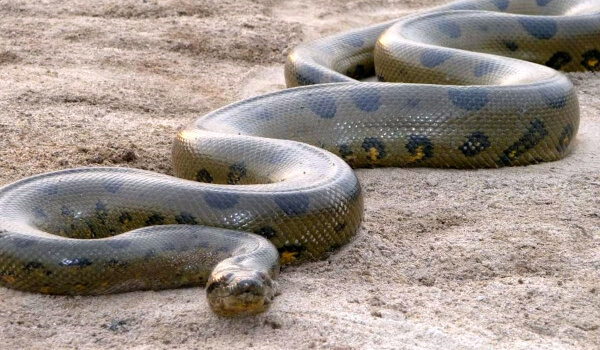
Photo: Anaconda snake
Anaconda is the largest snake, and in length it is inferior to the reticulated python, but in terms of weight it is the largest. It is interesting to note that the females of these snakes are larger than the males. The maximum measured length of the anaconda was 5.4 meters, with a weight of 100 kg. But in nature, there are probably individuals a little larger. According to experts, anacondas can reach a length of 6.7 meters and a weight of 130 kg.
The average length of the snake is 3 — 4 meters, and weight 50 — 70 kg. The diameter of the reptile reaches 35 cm, swallowing the victim is stretched to the desired size. Snakes grow throughout their lives, the first years are much more intense than after, but it is safe to assume that the largest individuals are of solid age.
Video: Anaconda
The head is small compared to the body, but the open mouth is huge and capable of stretching, like the pharynx. This allows the anaconda to pay less attention to the volume of the victim. The teeth are short, they can bite painfully. But the fangs are absent, if the victim is swallowed, they would only interfere. Saliva is harmless and there are no poisonous glands. The wound will be painful, but safe for life.
The color of the anaconda masks it against the background of its habitats. These are reservoirs, shallow water, tropics. The body color is close to marsh, gray-green. There are two rows of dark, brown, brown spots on the back. They are round or oblong up to 10 cm in diameter, solid color, alternate in a checkerboard pattern. And on the sides there are completely lighter stripes strewn with small spots. Sometimes the spots are hollow, like rings, or uneven circles. The diameter of these is from 1 to 3 cm. The back of the snake is often darker than the belly.
Where does the anaconda live?
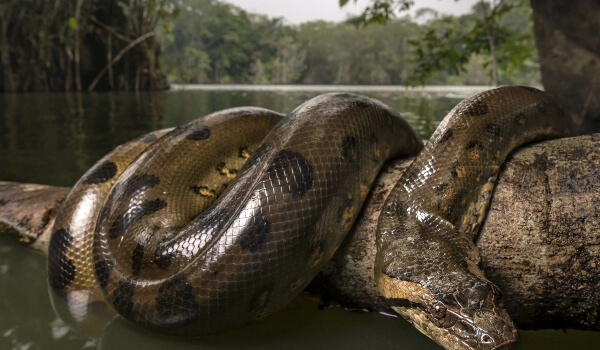
Photo: Big Anaconda
The habitat of the anaconda is almost the entire mainland — South America, except for the southern part of it. Of course, the climate at all latitudes is not suitable for the snake to live, since it is already a very long stretch from north to south near the mainland. To the east of the Andes, countries such as Brazil, Peru, Bolivia, Paraguay, Venezuela, Ecuador, Colombia, Guyana, French Guiana serve as the habitat of the anaconda. The island of Trinidad is singled out separately.
If considered by subspecies, then the giant anaconda lives in all the tropics. Paraguayan respectively in Paraguay, as well as Uruguay, Argentina, Brazil and northern Bolivia. Deshauer has only been seen in northern Brazil. And the subspecies Eunectes beniensis lives only in the tropics of Bolivia.
Anacondas prefer swamps, enclosed bodies of water or calm wide rivers. Snakes do not like a strong current; they prefer calmness to match their character. They can swim and stay under water for a long time. The structure of the nostrils includes special valves to block the flow of moisture into the respiratory tract.
Anacondas can dry on the shore or trees in the open sun, but they need moisture, they make sure that they are near a body of water. The rough surface of the belly in the form of scales helps them move on land. A powerful muscular body uses the friction of the outer cover and, thus, bending in every possible way, quickly moves.
If the reservoirs dry up, the snake cannot exist normally. To survive hard times, it burrows into the bottom of the former swamp, into silt and slush, and can become numb until better times.
What does the anaconda eat?
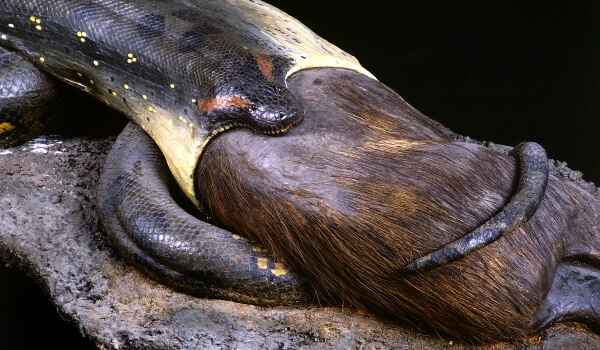
Photo: Anaconda eating
Thanks to the complex structure of the jaws and pharynx, equipped with elastic ligaments, the anaconda is able to swallow prey larger than it is. However, this is not always easy, and prey of such dimensions will not go into the mouth on its own. It happens the other way around — when trying to attack, for example, crocodiles, she herself becomes a victim. But the fact remains.
Still, the basis of the diet of the anaconda is made up of smaller living creatures, namely:
- small mammals (mouse voles, capybaras, agoutis, even sheep and dogs near the territory of agriculture can become its prey);
- reptiles (frogs, iguanas, lizards);
- turtles;
- waterfowl;
- their own kind (pythons, and even smaller anacondas themselves);
- fish in rare cases.
The hunt goes like this: the anaconda lurks in the water and watches the potential prey. Her eyes do not blink, for which people interpret her gaze as a process of hypnosis. At the right moment, the anaconda pounces on the victim with the whole body at once, without even using its teeth. Her body squeezes the animal’s chest, preventing it from breathing, and can also break its bones.
Next, she simply swallows her prey whole and digests it. Now she does not need to worry about her food for a week, or even months in advance. She will gradually be saturated and receive nutrients, slowly digesting the contents of the stomach in a passive lying position. Stomach acids are so strong that even bones are digested. The next time the anaconda wants to dine will not be soon.
Having such a powerful body, they absolutely do not need poison, because they are always able to crush a victim commensurate with themselves and without fatal bites. Cannibalism is also common among anacondas.
Character and lifestyle features
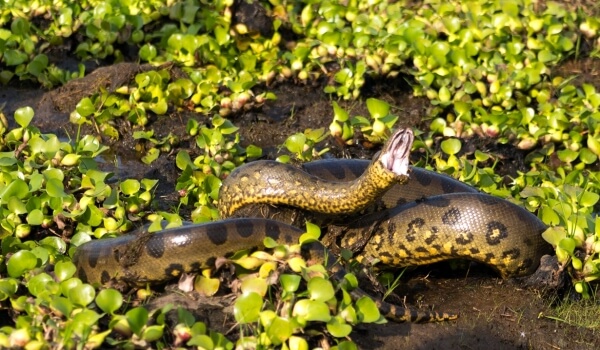
Photo: Giant Anaconda
The nature of anacondas is very apathetic. They can lie for hours without moving at all. Sometimes it seems that they are not alive at all. Probably, in the wild, this is exactly what the calculation was made for, the anaconda merges with the environment and no one touches it. Like all snakes, anacondas periodically undergo molting. Then they need to make auxiliary movements. They curl and rub against the bottom and stones in the pond. The rind peels off entirely, is removed like a stocking and remains in the water. The renewed snake continues its life in a new skin.
Anacondas cannot exist without moisture. Of course, it happens that they crawl out to lie in the sun or wrap around a tree trunk, but soon they calmly return to their familiar environment. If the snakes see that their pond is drying up, then they are looking for another one. Often they follow the current to greater depths of the rivers. During the drought period, anacondas burrow into the mud, looking for a cooler place with plenty of water. There they can go into a stupor for months before the rains come and the rivers fill.
Anacondas are so quiet animals that if you do not look for them specifically, you may not find them. Perhaps that is why they were singled out as a separate species only at the end of the 20th century. From the sounds they make only a faint hiss. The lifespan of anacondas is not exactly known. They have been shown to have a low survival rate in captivity. Terrariums are capable of keeping anacondas alive for 5 — 6 years. It is clear that this period is longer in the natural habitat, but it is not clear by how much.
For example, the record anaconda lifespan in captivity has been recorded at 28 years. Again, it is unlikely that an individual is able to survive all natural disasters without consequences, and probably somewhere in the range of this data is the average life expectancy of this species.
Social structure and reproduction
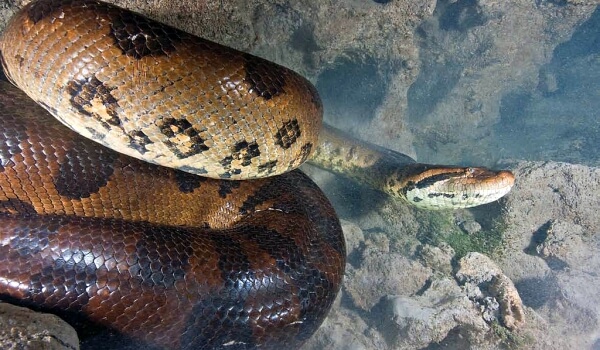
Photo: Anaconda animal
Anacondas are solitary are not in contact with each other. Moreover, they can attack and eat their relative if he is inferior to them in size. Only during the mating season do they begin to treat each other with indifference.
Males start chasing females. They are easy to find by the fetid trail that they leave on purpose when they feel ready to mate. Often several contenders crawl for one female at once. The males start fighting each other. They wrap around and squeeze the opponent, intertwine into a ball. Unable to withstand pressure, it is soon removed. The advantage, as a rule, is with larger males. The winner gets the opportunity to mate with the female.
The gestation period lasts about six months. During this time, the female almost does not move and does not eat anything. She loses a lot of weight, it happens to be reduced by half. Anacondas are ovoviviparous reptiles. The cubs hatch from eggs while still in the womb and crawl out as kites, about half a meter long. There are 30 — 50 pieces. Little snakes are ready for independent existence. Few manage to survive. While they are small — they are very vulnerable to other animals and even other older anacondas.
Natural enemies of the anaconda
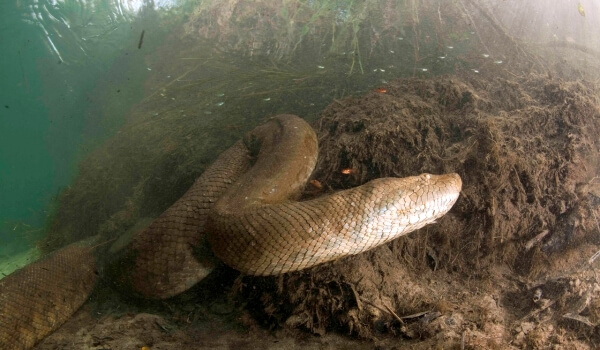
Photo: Anaconda Boa
An adult anaconda has very few enemies among the animals living around. Few can match her strength. Even crocodiles, far from always attacking an anaconda, can overcome it. The danger to these creatures threatens more in childhood, while they are not yet so strong. First of all, older anacondas or pythons can eat them. And crocodiles can easily handle them. But if the anaconda succeeds, despite all the difficulties of a child’s life, to become an adult — few people will interfere with her peaceful existence.
For adult anacondas, only people are of great danger. Indians hunters kill them with the help of various tools. There are no failures. If a person wants to get himself a dead snake — he will do it. They are mined mainly for their meat. This dish is very popular in South America. It is eaten by both locals and visiting tourists. It is tender and sweetish in taste, many people like it very much. The snake skin is also very valuable. It is used for fashion clothes and accessories. Snake skin is used by designers in furniture and for various kinds of decor.
Species population and status
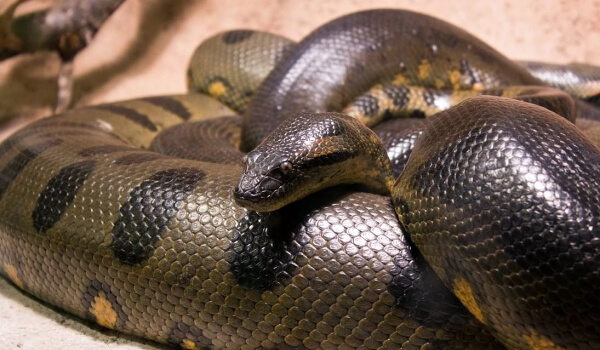
Photo: Long Anaconda
Anacondas need such habitat conditions that a person approaches quite rarely. It is very difficult to conduct expeditions in the jungle, to explore the reservoirs and their contents. Therefore, it is problematic to estimate even approximately the number of anaconda individuals.
The extraction of anacondas for the zoo is always successful, it is always possible to find the right number of individuals. Hunting for anacondas by local residents does not stop and does not cause difficulties, therefore, their numbers are quite dense. Near agriculture, there are cases of anaconda attacks on livestock, which also indicates their stable abundance.
Of course, much is not written about anacondas in the Red Book, the conservation status indicates — «the threat was not assessed». Nevertheless, experts believe that this species is out of danger and has all the necessary conditions for a comfortable existence and reproduction. So it is — rainforests, jungles and swamps are the least affected by human encroachment, development, tourism development and environmental pollution. Therefore, the factors that interfere with the normal life of anacondas will not reach these places so soon. Anaconda can live in peace, its population is not threatened yet.

